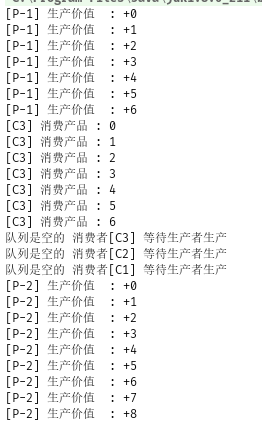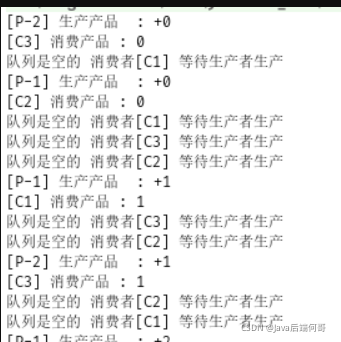前言:生产者—消费者模式是如此的重要,是理解 Java 多线程并发和消息队列的核心知识点,不少同学面试时,常规操作是当着面试官的面,手写一个生产者消费者模式。我今年参加美团社招就被要求手写生产者-消费者模式,当时是一脸懵逼。俗话说,从哪里跌倒就要从哪里爬起来,今天我决定手敲一个生产者消费者模式压压惊。
一、生产者-消费者模式
生产者消费者模式,其实很简单。无非就是生产者不停的生产数据,消费者不停的消费数据。
1.1、生产者-消费者模式设计要求
这种设计模式需要满足以下三点要求:
(1)生产者生产数据到缓冲区中,消费者从缓冲区中取数据。
(2)如果缓冲区已经满了,则生产者线程阻塞;
(3)如果缓冲区为空,那么消费者线程阻塞。
编写之前分析:
(1)定义一个缓存队列,选择一个集合当做缓存,给予缓存上限,缓存队列只有两种行为(生产数据和消费数据);
(2)定义一个生产者线程,调用缓存队列中的生产行为;
(3)定义一个消费者线程,调用缓存队列中的消费行为;
1.2、生产者-消费者模实现方式
通常情况下,有三种方式来实现
(1)synchronized + wait() + notify() 方式
(2) 可重入锁ReentrantLock (配合Condition)
(3) BlockingQueue 阻塞队列方式
一般面试官不允许你用阻塞队列实现,所以生产者消费者模式我们可以用sychronized+wait+notify版本写,更加高阶的可以用Reentranlock版本+condition(条件变量)来写。为了达到精准通知的目的,我们还可以使用ReentrantLock版本+多个condition(条件变量来写)。
二、Object的wait-notify-notifyAll简介
2.1、Object的wait、notify和notifyAll方法
wait方法
当一个线程调用一个共享变量的wait()方法时,该调用线程会被阻塞挂起(进入waiting状态),直到发生下面几件事情之一才能返回:
-
其他线程调用了该共享对象的notify()或者notifyAll()方法;
-
其他线程调用了该线程的interrupt()方法,该线程抛出InterruptedException异常返回。
另外需要注意的是,如果调用wait()方法的线程没有事先获取该对象的监视器锁,则调用wait()方法时调用线程会抛出IllegalMonitorStateException异常。如果当前线程已经获取了锁资源,调用wait方法之后会释放这个锁资源,但是只会释放当前共享变量上的锁,如果当前线程还持有其他共享变量的锁,则这些锁是不会被释放的。
wait方法还有一个重载方法wait(long time),这个方法会等待time时间,如果在这个时间内没有其他线程来唤醒它的话,这个线程会自己唤醒继续获得执行机会。
notify方法
notify方法会唤醒等待对象监视器的单个线程,如果等待对象监视器的有多个线程,则选取其中一个线程进行唤醒,到底选择唤醒哪个线程是任意的,由CPU自己决定。如果没有再调用notify方法,其他阻塞的线程可能就永远得不到再执行的机会了。
此外,被唤醒的线程不能马上从wait方法返回并继续执行,它必须在获取了共享对象的监视器锁后才可以返回,也就是唤醒它的线程释放了共享变量上的监视器锁后,被唤醒的线程也不一定会获取到共享对象的监视器锁,这是因为该线程还需要和其他线程一起竞争该锁,只有该线程竞争到了共享变量的监视器锁后才可以继续执行。
一个还需要注意的地方是,在共享变量上调用notifyAll()方法只会唤醒调用这个方法前调用了wait系列函数而被放入共享变量等待集合里面的线程。如果调用notifyAll()方法后一个线程调用了该共享变量的wait()方法而被放入阻塞集合,则该线程是不会被唤醒的
类似wait系列方法,只有当前线程获取到了共享变量的监视器锁后,才可以调用共享变量的notify()方法,否则会抛出IllegalMonitorStateException异常。
notifyAll方法
notify方法还有个兄弟方法notifyAll,这个方法会唤醒所有等待监视器对象的线程。
2.2、wait-notify模式的典型应用
wait-notify模式的一个典型应用就是可以实现生产者-消费者模式
有10个人向这个箱子中每次随机放入一个苹果,有10个人每次随机从这个箱子中随机拿走一个苹果,同时需要满足箱子中的苹果总数不能超过50个。请用代码实现上面的场景(不能使用并发集合框架或者阻塞队列)
public class AppleBox {
private int appleCount;
public synchronized void putApple() {
while (appleCount >= 50) {
try {
//会释放锁
this.wait();
} catch (InterruptedException e) {
e.printStackTrace();
}
}
appleCount++;
String name = Thread.currentThread().getName();
System.out.println("[" + name + "]放入一个,当前盒子中苹果数:" + appleCount);
this.notifyAll();
}
public synchronized void takeApple() {
while (appleCount <= 0) {
try {
//会释放锁
this.wait();
} catch (InterruptedException e) {
e.printStackTrace();
}
}
appleCount--;
String name = Thread.currentThread().getName();
System.out.println("[" + name + "]拿走一个,当前盒子中苹果数:" + appleCount);
this.notifyAll();
}
private static class AppleTaker implements Runnable {
private AppleBox appleBox;
public AppleTaker(AppleBox appleBox) {
this.appleBox = appleBox;
}
@Override
public void run() {
while (true) {
appleBox.takeApple();
try {
TimeUnit.MILLISECONDS.sleep(100);
} catch (InterruptedException e) {
e.printStackTrace();
}
}
}
}
private static class ApplePutter implements Runnable {
private AppleBox appleBox;
public ApplePutter(AppleBox appleBox) {
this.appleBox = appleBox;
}
@Override
public void run() {
while (true) {
appleBox.putApple();
try {
TimeUnit.MILLISECONDS.sleep(100);
} catch (InterruptedException e) {
e.printStackTrace();
}
}
}
}
public static void main(String[] args) {
AppleBox appleBox = new AppleBox();
for (int i = 0; i < 20; i++) {
Thread t = new Thread(new ApplePutter(appleBox));
t.setName("ApplePutter:" + i);
t.start();
}
for (int i = 0; i < 20; i++) {
Thread t = new Thread(new AppleTaker(appleBox));
t.setName("AppleTaker:" + i);
t.start();
}
}
}
执行结果如下:
[ApplePutter:0]放入一个,当前盒子中苹果数:1
[ApplePutter:1]放入一个,当前盒子中苹果数:2
[ApplePutter:5]放入一个,当前盒子中苹果数:3
[ApplePutter:9]放入一个,当前盒子中苹果数:4
[ApplePutter:13]放入一个,当前盒子中苹果数:5
[ApplePutter:2]放入一个,当前盒子中苹果数:6
[ApplePutter:6]放入一个,当前盒子中苹果数:7
[ApplePutter:10]放入一个,当前盒子中苹果数:8
[ApplePutter:17]放入一个,当前盒子中苹果数:9
[ApplePutter:14]放入一个,当前盒子中苹果数:10
[ApplePutter:18]放入一个,当前盒子中苹果数:11
[ApplePutter:3]放入一个,当前盒子中苹果数:12
[ApplePutter:7]放入一个,当前盒子中苹果数:13
[ApplePutter:11]放入一个,当前盒子中苹果数:14
[ApplePutter:8]放入一个,当前盒子中苹果数:15
[ApplePutter:15]放入一个,当前盒子中苹果数:16
[ApplePutter:19]放入一个,当前盒子中苹果数:17
[ApplePutter:4]放入一个,当前盒子中苹果数:18
[AppleTaker:3]拿走一个,当前盒子中苹果数:17
[ApplePutter:12]放入一个,当前盒子中苹果数:18
[AppleTaker:1]拿走一个,当前盒子中苹果数:17
[AppleTaker:5]拿走一个,当前盒子中苹果数:16
[ApplePutter:16]放入一个,当前盒子中苹果数:17
[AppleTaker:0]拿走一个,当前盒子中苹果数:16
[AppleTaker:12]拿走一个,当前盒子中苹果数:15
[AppleTaker:8]拿走一个,当前盒子中苹果数:14
[AppleTaker:16]拿走一个,当前盒子中苹果数:13
[AppleTaker:7]拿走一个,当前盒子中苹果数:12
[AppleTaker:11]拿走一个,当前盒子中苹果数:11
[AppleTaker:19]拿走一个,当前盒子中苹果数:10
[AppleTaker:9]拿走一个,当前盒子中苹果数:9
[AppleTaker:13]拿走一个,当前盒子中苹果数:8
[AppleTaker:2]拿走一个,当前盒子中苹果数:7
[AppleTaker:6]拿走一个,当前盒子中苹果数:6
[AppleTaker:10]拿走一个,当前盒子中苹果数:5
[AppleTaker:14]拿走一个,当前盒子中苹果数:4
[AppleTaker:4]拿走一个,当前盒子中苹果数:3
[AppleTaker:15]拿走一个,当前盒子中苹果数:2
[AppleTaker:18]拿走一个,当前盒子中苹果数:1
[AppleTaker:17]拿走一个,当前盒子中苹果数:0
[ApplePutter:0]放入一个,当前盒子中苹果数:1
[ApplePutter:1]放入一个,当前盒子中苹果数:2
[ApplePutter:5]放入一个,当前盒子中苹果数:3
[ApplePutter:9]放入一个,当前盒子中苹果数:4
[ApplePutter:13]放入一个,当前盒子中苹果数:5
[ApplePutter:17]放入一个,当前盒子中苹果数:6
[ApplePutter:2]放入一个,当前盒子中苹果数:7
[ApplePutter:6]放入一个,当前盒子中苹果数:8
[ApplePutter:10]放入一个,当前盒子中苹果数:9
[ApplePutter:14]放入一个,当前盒子中苹果数:10
[ApplePutter:18]放入一个,当前盒子中苹果数:11
[ApplePutter:3]放入一个,当前盒子中苹果数:12
[ApplePutter:7]放入一个,当前盒子中苹果数:13
[ApplePutter:11]放入一个,当前盒子中苹果数:14
[ApplePutter:15]放入一个,当前盒子中苹果数:15
[ApplePutter:19]放入一个,当前盒子中苹果数:16
[AppleTaker:3]拿走一个,当前盒子中苹果数:15
[ApplePutter:4]放入一个,当前盒子中苹果数:16
[ApplePutter:8]放入一个,当前盒子中苹果数:17
[ApplePutter:12]放入一个,当前盒子中苹果数:18
**PS: 多线程编程中,最要的重要的两点是先抽象出共享变量是什么,任务类(Runner)是什么 **
2.3、wait-notify模式的经典写法
生产者和消费者的逻辑都可以统一抽象成以下几个步骤:
-
step1:获得对象的锁;
-
step2:循环判断是否需要进行生产活动,如果不需要进行生产就调用wait方法,暂停当前线程;如果需要进行生产活动,进行对应的生产活动;
-
step3:通知等待线程
伪代码如下:
synchronized(对象) {
//这边进行循环判断的原因是为了防止伪唤醒,也就是不是消费线程或者生产线程调用notify方法将waiting线程唤醒的
while(条件){
对象.wait();
}
//进行生产或者消费活动
doSomething();
对象.notifyAll();
}三、sychronized+wait()-notify()方法实现
wait()/ nofity()方法是基类Object的两个方法,也就意味着所有Java类都会拥有这两个方法,这样,我们就可以为任何对象实现同步机制。
wait():当缓冲区已满/空时,生产者/消费者线程停止自己的执行,放弃锁,使自己处于等待状态,让其他线程执行。
notify():当生产者/消费者向缓冲区放入/取出一个产品时,向其他等待的线程发出可执行的通知,同时放弃锁,使自己处于等待状态。
生产者
import java.util.Queue;
import java.util.Random;
public class Producer extends Thread {
private Queue<Integer> queue;
String name;
int maxSize;
int i=0;
public Producer(String name,Queue<Integer> queue,int maxSize){
super(name);
this.name=name;
this.queue=queue;
this.maxSize=maxSize;
}
@Override
public void run(){
while (true){
synchronized (queue){
while (queue.size()==maxSize){
try{
System.out.println("队列已经满了,生产者["+name+"]线程等待"+"消费者从队列中消费产品。");
queue.wait();
}catch (Exception e){
e.printStackTrace();
}
}
System.out.println("[" + name + "] 生产产品 : +" + i);
queue.offer(i++);
queue.notifyAll();
try{
Thread.sleep(new Random().nextInt(1000));
}catch (InterruptedException e){
e.printStackTrace();
}
}
}
}
}
消费者
import java.util.Queue;
import java.util.Random;
public class Consumer extends Thread {
private Queue<Integer> queue;
String name;
int maxSize;
public Consumer(String name,Queue<Integer>queue,int maxSize){
super(name);
this.name=name;
this.queue=queue;
this.maxSize=maxSize;
}
@Override
public void run(){
while (true){
synchronized (queue){
while (queue.isEmpty()){
try{
System.out.println("队列是空的 消费者[" + name + "] 等待生产者生产");
queue.wait();
}catch (Exception e){
e.printStackTrace();
}
}
int x=queue.poll();
System.out.println("[" + name + "] 消费产品 : " + x);
queue.notifyAll();
try{
Thread.sleep(new Random().nextInt(1000));
}catch (InterruptedException e){
e.printStackTrace();
}
}
}
}
}
生产者消费者模式
import java.util.LinkedList;
import java.util.Queue;
/**
* 生产者消费者模式:使用Object.wait()/notify()方法实现
*/
public class ProdicerConsumer {
private static final int CAPACITY = 500;
public static void main(String[] args) {
Queue<Integer> queue = new LinkedList<Integer>();
Thread producer1 = new Producer("P-1", queue, CAPACITY);
Thread producer2 = new Producer("P-2", queue, CAPACITY);
Thread consumer1 = new Consumer("C1", queue, CAPACITY);
Thread consumer2 = new Consumer("C2", queue, CAPACITY);
Thread consumer3 = new Consumer("C3", queue, CAPACITY);
producer1.start();
producer2.start();
consumer1.start();
consumer2.start();
consumer3.start();
}
}输出结果:

注意要点
判断Queue大小为0或者大于queueSize时须使用 while (condition) {},不能使用 if(condition) {}。其中 while(condition)循环,它又被叫做“自旋锁”。为防止该线程没有收到notify()调用也从wait()中返回(也称作虚假唤醒),这个线程会重新去检查condition条件以决定当前是否可以安全地继续执行还是需要重新保持等待,而不是认为线程被唤醒了就可以安全地继续执行了。
四、使用Reentranlock和Condition的await() / signal()方法实现
在JDK5.0之后,Java提供了更加健壮的线程处理机制,包括同步、锁定、线程池等,它们可以实现更细粒度的线程控制。Condition接口的await()和signal()就是其中用来做同步的两种方法,它们的功能基本上和Object的wait()/ nofity()相同,完全可以取代它们,但是它们和新引入的锁定机制Lock直接挂钩,具有更大的灵活性。通过在Lock对象上调用newCondition()方法,将条件变量和一个锁对象进行绑定,进而控制并发程序访问竞争资源的安全。
生产者消费者模式:使用Lock和Condition实现
import java.util.LinkedList;
import java.util.Queue;
import java.util.Random;
import java.util.concurrent.locks.Condition;
import java.util.concurrent.locks.Lock;
import java.util.concurrent.locks.ReentrantLock;
public class ProducerConsumerByLock {
private static final int CAPACITY = 5;
private static final Lock lock = new ReentrantLock();
private static final Condition fullCondition = lock.newCondition(); //队列满的条件
private static final Condition emptyCondition = lock.newCondition(); //队列空的条件
public static void main(String args[]){
Queue<Integer> queue = new LinkedList<Integer>();
Thread producer1 = new Producer("P-1", queue, CAPACITY);
Thread producer2 = new Producer("P-2", queue, CAPACITY);
Thread consumer1 = new Consumer("C1", queue, CAPACITY);
Thread consumer2 = new Consumer("C2", queue, CAPACITY);
Thread consumer3 = new Consumer("C3", queue, CAPACITY);
producer1.start();
producer2.start();
consumer1.start();
consumer2.start();
consumer3.start();
}
/**
* 生产者
*/
public static class Producer extends Thread{
private Queue<Integer> queue;
String name;
int maxSize;
int i = 0;
public Producer(String name, Queue<Integer> queue, int maxSize){
super(name);
this.name = name;
this.queue = queue;
this.maxSize = maxSize;
}
@Override
public void run(){
while(true){
//获得锁
lock.lock();
while(queue.size() == maxSize){
try {
System.out .println("队列已经满了,生产者["+name+"]线程等待"+"消费者从队列中消费产品。");
//条件不满足,生产阻塞
fullCondition.await();
} catch (InterruptedException ex) {
ex.printStackTrace();
}
}
System.out.println("[" + name + "] 生产产品 : +" + i);
queue.offer(i++);
//唤醒其他所有生产者、消费者
fullCondition.signalAll();
emptyCondition.signalAll();
//释放锁
lock.unlock();
try {
Thread.sleep(new Random().nextInt(1000));
} catch (InterruptedException e) {
e.printStackTrace();
}
}
}
}
/**
* 消费者
*/
public static class Consumer extends Thread{
private Queue<Integer> queue;
String name;
int maxSize;
public Consumer(String name, Queue<Integer> queue, int maxSize){
super(name);
this.name = name;
this.queue = queue;
this.maxSize = maxSize;
}
@Override
public void run(){
while(true){
//获得锁
lock.lock();
while(queue.isEmpty()){
try {
System.out.println("队列是空的 消费者[" + name + "] 等待生产者生产");
//条件不满足,消费阻塞
emptyCondition.await();
} catch (Exception ex) {
ex.printStackTrace();
}
}
int x = queue.poll();
System.out.println("[" + name + "] 消费产品 : " + x);
//唤醒其他所有生产者、消费者
fullCondition.signalAll();
emptyCondition.signalAll();
//释放锁
lock.unlock();
try {
Thread.sleep(new Random().nextInt(1000));
} catch (InterruptedException e) {
e.printStackTrace();
}
}
}
}
}
输出结果:

五、使用BlockingQueue阻塞队列实现
数据类Data
public class Data {
private int id;
//生产量
private int num;
public Data(int id,int num){
this.id=id;
this.num=num;
}
public Data(){
}
public int getId() {
return id;
}
public void setId(int id) {
this.id = id;
}
public int getNum() {
return num;
}
public void setNum(int num) {
this.num = num;
}
}
生产者
import java.util.Random;
import java.util.concurrent.BlockingDeque;
import java.util.concurrent.TimeUnit;
import java.util.concurrent.atomic.AtomicInteger;
public class Producer implements Runnable {
//共享阻塞队列
private BlockingDeque<Data> queue;
//是否还在运行
private volatile boolean isRunning = true;
//id生成器原子操作
private static AtomicInteger count = new AtomicInteger();
// 生成随机数
private static Random random = new Random();
public Producer(BlockingDeque<Data> queue){
this.queue=queue;
}
@Override
public void run() {
try{
while(isRunning){
// 模拟生产耗时
Thread.sleep(random.nextInt(1000));
int num=count.incrementAndGet();
Data data=new Data(num,num);
System.out.println("当前>>生产者:"+Thread.currentThread().getName()+"生产量"+num);
if(!queue.offer(data,2, TimeUnit.SECONDS)){
System.out.println("生产失败...");
}
}
}catch (Exception e){
e.printStackTrace();
}
}
public void stop(){
isRunning=false;
}
}
消费者
import java.util.Random;
import java.util.concurrent.BlockingDeque;
public class Consumer implements Runnable {
//双端队列,加入或者取出元素都是线程安全的
private BlockingDeque<Data> queue;
private static Random random=new Random();
public Consumer(BlockingDeque<Data> queue){
this.queue=queue;
}
@Override
public void run(){
while (true){
try{
// 检索并删除,如果需要等待、直到元素可用。
Data data= queue.take();
//模拟消费耗时
Thread.sleep(random.nextInt(1000));
if(data!=null){
System.out.println("当前<<消费者:"+Thread.currentThread().getName()+",消费量"+data.getNum());
}
}catch (Exception e){
e.printStackTrace();
}
}
}
}
测试
import java.util.concurrent.*;
public class TestPro {
public static void main(String[] args) throws InterruptedException{
BlockingDeque<Data> queue = new LinkedBlockingDeque<>(10);
Producer producer1 = new Producer(queue);
Producer producer2 = new Producer(queue);
Producer producer3 = new Producer(queue);
Consumer consumer1 = new Consumer(queue);
Consumer consumer2 = new Consumer(queue);
Consumer consumer3 = new Consumer(queue);
ExecutorService service= Executors.newCachedThreadPool();
service.execute(producer1);
service.execute(producer2);
service.execute(producer3);
service.execute(consumer1);
service.execute(consumer2);
service.execute(consumer3);
Thread.sleep(3000);
producer1.stop();
producer2.stop();
producer3.stop();
Thread.sleep(1000);
service.shutdown();
}
}

最后一次生产20此时所有的生产者都停止生产了,但是此时产品池还没空,于是消费者继续消费,直到把产品池中的数据消耗完
参考链接:






















 5922
5922











 被折叠的 条评论
为什么被折叠?
被折叠的 条评论
为什么被折叠?










